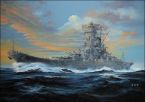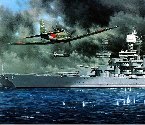engineer
Posts: 590
Joined: 9/8/2006
Status: offline

|
I take it that your hypothesis is that BB are less useful in WitP than they were historically.
Historically, they got the most use for shore bombardment, heavy AA platforms, and only incidentally as classical gun ships. The other thing they did in WW2 was a "non-use" use as a potential opponent to impose caution on the opponent and restrict his freedom of action. My own experience is still heavily weighted to WPO, but I'm not so sure I agree with the hypothesis.
For bombardment, I've found my destroyers so gutted by relatively modest shore defenses time and again that I don't even risk escorts in front of CD guns any more. Destroyers are effective against non-CD LCU's, but my experience is that the weight of BB fire tells. You can't linger and repeatedly bombard since the main gun ammo is largely expended in a single bombardment, but that is fairly historical. Cruisers and destroyers and better for the sustained bombardments, but does that raise the question of whether the capacity of the 8" and smaller guns is too high? The battle ships seem ok in this respect, subject to the caveat about "nuclear shore bombardments" (In WPO I led a battleline of Tillman's into Tokyo Bay and inflicted 125,000 casualties one night during the conquest of Honshu), But I think this is folded into stacking.
I have to admit that my WitP experience hasn't escaped 1942 yet so I really don't have a feel for how adding ships with 1000+ flak improve the odds of surviving air strikes. I seen other comments in the Forum commend Allied battleships in that role.
The Pacific only saw a handful of battleship surface engagements (Guadalcanal and Surigao Strait come to mind) However, the threat of Japanese sorties weighed heavily on the operations around Guadalcanal and contingency planning for the Allied counter-offensive in 1943-1945. In WitP, I've only seen one, a night battle where PoW and Repulse met Kongo and Haruna off Kuantan in the opening weeks of the campaign scenario. Kongo was mortally wounded and Repulse took a torpedo on the last round of combat. She was out of action until July. I think that's a reasonable result, if one that probably errs on the side of British good fortune since there were plenty of destroyers on both sides filling the ocean with torpedos that night. A little more damage and Japanese air power would have finished off the British ships before they made it back to Singapore.
However, this interplay of surface combat and air power is one of the big differences between WitP and WPO. In the latter, the ocean is vast and battles erupt over the various islands that serve as bases for shorter ranged ships. In WitP, airpower makes the ocean "sticky" since a spotting report can bring Betty's from a long way. In looking at how the various naval commands responded to the environment, the US suspended the Montana's in the design stage and did not [edit] finish the last New Jersey's. The Shinano was completed as a carrier. Ise and Hyuga got their conversions. The British did finish Vanguard after the war, but ASW assets really became their priority early on.
To paraphrase Rumsfeld, you fight the war with the navy you have. But by 1945, it was pretty clear that battleships had a poor cost/benefit ratio compared to an equivalent tonnage of carriers, subs, or cruisers.
< Message edited by engineer -- 3/11/2008 9:09:38 PM >
|
 Printable Version
Printable Version















 New Messages
New Messages No New Messages
No New Messages Hot Topic w/ New Messages
Hot Topic w/ New Messages Hot Topic w/o New Messages
Hot Topic w/o New Messages Locked w/ New Messages
Locked w/ New Messages Locked w/o New Messages
Locked w/o New Messages Post New Thread
Post New Thread